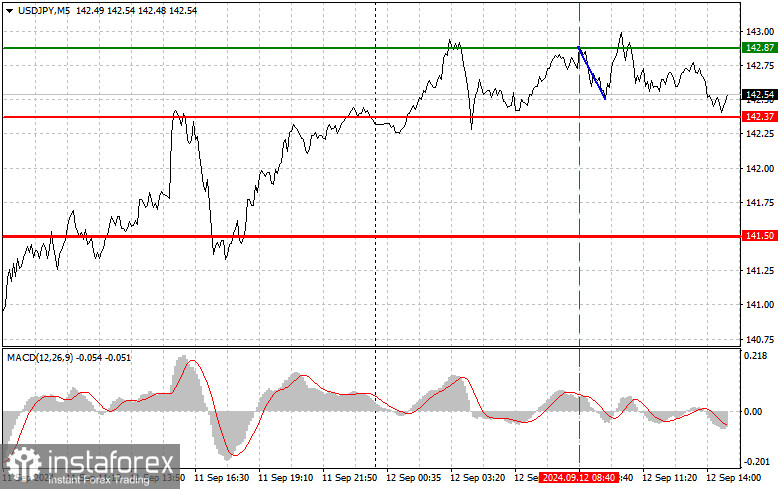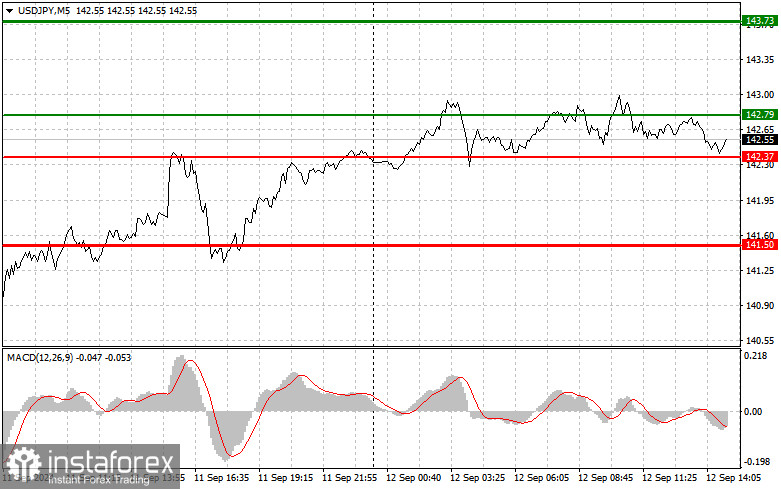Analysis of Trades and Tips for Trading the Japanese Yen
The test of the 142.87 price occurred when the MACD indicator had remained in the overbought zone for quite some time, which allowed Scenario #2 for selling to be executed, continuing the downward trend. This resulted in a 30-point decline in the dollar, after which trading continued within the channel. In the second half of the day, the pair will only be able to break out of the trading range if convincing U.S. statistics are released. Reports are expected on the number of initial jobless claims, the Producer Price Index (PPI), and core PPI for August. Only a sharp increase in these figures can halt the recent downward trend observed in the dollar against the Japanese yen. If the data matches economists' forecasts as expected, USD/JPY will likely continue to decline. Regarding intraday strategy, I plan to act based on Scenario #1, even considering the MACD indicator readings, as I expect strong and directional movement in the pair.

Buy Signal
Scenario #1: Today, I plan to buy USD/JPY at the entry point around 142.79 (green line on the chart) with a target of rising to 143.73 (thicker green line on the chart). At 143.73, I will close the buy positions and open short positions, expecting a 30-35 point move in the opposite direction. A rise in the pair can be expected today after strong U.S. data. Important: Before buying, make sure that the MACD indicator is above the zero level and just beginning to rise from it.
Scenario #2: I also plan to buy USD/JPY today if there are two consecutive tests of the 142.37 price level when the MACD indicator is in the oversold zone. This will limit the pair's downward potential and lead to a market reversal upward. Growth to the levels of 142.79 and 143.73 can be expected.
Sell Signal
Scenario #1: I plan to sell USD/JPY after breaking below the 142.37 level (red line on the chart), which should lead to a quick decline. The key target for sellers will be 141.50, where I will close the short positions and immediately open long positions (expecting a move of 20-25 points in the opposite direction). Selling pressure on the pair will return if U.S. statistics are poor. Important: Before selling, make sure that the MACD indicator is below the zero level and just beginning to fall from it.
Scenario #2: I also plan to sell USD/JPY today if there are two consecutive tests of the 142.79 price level when the MACD indicator is in the overbought zone. This will limit the pair's upward potential and lead to a market reversal downward. A drop can be expected to the opposite levels of 142.37 and 141.50.

What is shown on the chart:
- Thin green line – the price at which the trading instrument can be bought;
- Thick green line – the assumed price where Take Profit can be set or profits can be manually fixed, as further growth above this level is unlikely;
- Thin red line – the price at which the trading instrument can be sold;
- Thick red line – the assumed price where Take Profit can be set or profits can be manually fixed, as further decline below this level is unlikely;
- MACD Indicator – When entering the market, it's important to consider overbought and oversold zones.
Important: Beginner traders in the Forex market need to be very cautious when making decisions to enter the market. Before major fundamental reports are released, it's best to stay out of the market to avoid sharp price swings. If you decide to trade during news releases, always set stop-loss orders to minimize losses. Without stop-losses, you can quickly lose your entire deposit, especially if you don't use proper money management or trade in large volumes.
And remember, for successful trading, you need a clear trading plan, like the one outlined above. Making spontaneous trading decisions based on the current market situation is a fundamentally losing strategy for intraday traders.





















